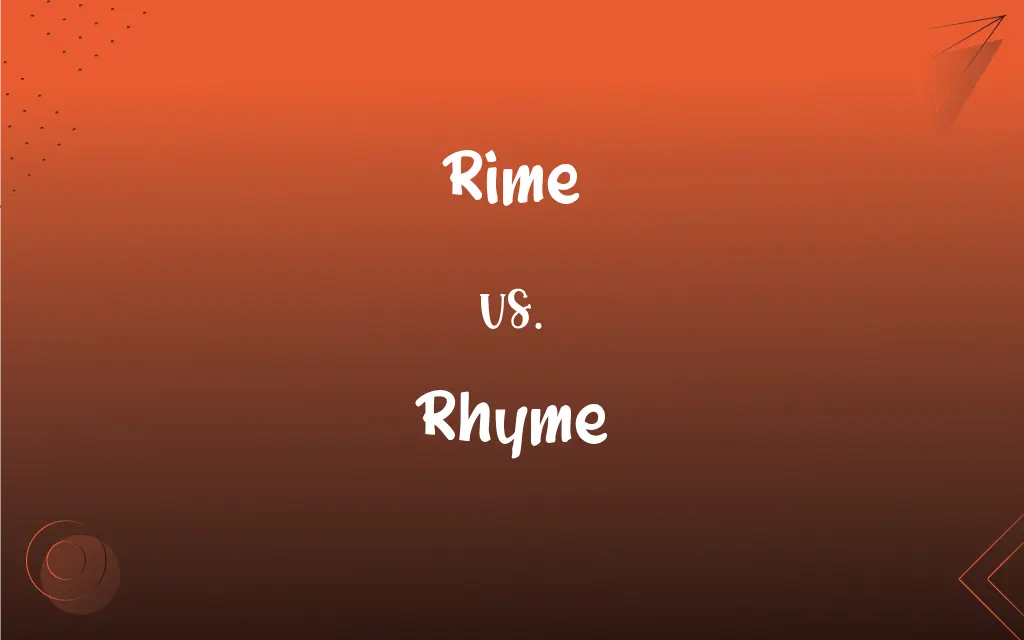Rime vs. Rhyme: What's the Difference?
Edited by Aimie Carlson || By Janet White || Published on December 15, 2023
'Rime' refers to a frost formed on cold objects, while 'rhyme' denotes the repetition of similar sounds in words, often in poetry.

Key Differences
Rime is a type of frost that forms on cold, exposed surfaces, often creating white, feathery crystal structures. Rhyme, in contrast, is a literary device used in poetry and song, where similar or identical sounds at the end of words create a harmonious effect.
The term 'rime' is primarily used in meteorology and climatology, describing a natural weather phenomenon. Rhyme, however, is a foundational element of poetry and music, playing a crucial role in the aesthetics of language and sound.
Rime occurs when water vapor freezes directly onto surfaces, typically seen in cold and humid conditions. Rhyme, as a poetic technique, involves the deliberate use of words with similar ending sounds, enhancing rhythm and musicality in language.
In the context of 'rime', the focus is on the physical appearance and structure of the frost. In 'rhyme', the emphasis is on the phonetic and auditory similarity between words or syllables.
'Rime' is observable in nature, often admired for its intricate and delicate patterns. 'Rhyme' is an artistic and linguistic tool, used by poets and lyricists to create patterns of sound that are pleasing to the ear.
ADVERTISEMENT
Comparison Chart
Definition
Frost formation on surfaces
Repetition of similar sounds in words
Context
Meteorology, climatology
Poetry, music
Occurrence
Natural, in cold conditions
Artistic, in language and sound
Focus
Physical appearance
Phonetic similarity
Use
Observable in nature
Creates rhythm and musicality in language
ADVERTISEMENT
Rime and Rhyme Definitions
Rime
Ice Crystals.
The rime created intricate patterns on the leaves. (Ice crystals forming patterns)
Rhyme
Matching Sounds.
The rhyme of 'cat' and 'hat' is simple yet effective.
Rime
Cold Condition Effect.
Rime often forms in high, cold places. (Common in high altitude areas)
Rhyme
Sound Repetition.
The poem used rhyme to create a musical effect.
Rime
Weather Phenomenon.
We observed rime on the window during the winter morning. (Natural occurrence in winter)
Rhyme
Poetic Device.
She loves writing verses with clever rhyme.
Rime
Frost Formation.
The trees were covered in a beautiful rime after the cold night. (Frost forming on objects)
Rhyme
Musicality in Language.
Rhyme adds rhythm and flow to songs.
Rime
White Coating.
A layer of rime coated the metal railings. (White frost covering objects)
Rhyme
End of Words.
The rhyme scheme was ABAB in his sonnet.
Rime
A white incrustation of ice formed when supercooled water droplets freeze almost instantly on contact with a solid surface.
Rhyme
Correspondence of sounds at the ends of words or phrases, especially when involving the last stressed vowel and all succeeding sounds in each of two or more such words or phrases.
Rhyme
A word that exhibits such correspondence with another, as behold and cold.
FAQs
Where is rime commonly found?
Often in cold, humid conditions, like high-altitude areas.
Can rime be artificially created?
It typically occurs naturally, under specific environmental conditions.
What is rime in nature?
Rime is a type of frost that forms on cold objects.
Is rime related to snow?
It's similar but forms differently, directly from water vapor.
What is a rhyme scheme?
The pattern of rhymes at the end of each line in a poem.
What is the purpose of rhyme in poetry?
To create rhythm, musicality, and aesthetic pleasure.
Is rhyme necessary for poetry?
Not necessary, but it's a popular stylistic device.
What does rime look like?
It's a white, feathery frost that coats surfaces.
Can rhyme occur in prose?
Yes, but it's more commonly used in poetry and songs.
Is rime harmful?
It's generally not harmful, though it can indicate extreme cold.
Can rhyme be used in all languages?
It's present in many languages, though its form can vary.
Are there different forms of rime?
Yes, including hard rime and soft rime, depending on conditions.
Are there different types of rhyme?
Yes, including perfect, slant, and internal rhymes.
How does rhyme affect a poem?
It can enhance its rhythm, flow, and memorability.
Does rime affect the environment?
It can impact local ecosystems, like plant life under the frost.
Is rhyme the same as rhythm?
They're related, but rhyme is about sound similarity, rhythm about beat.
Does rhyme have rules?
There are conventions, but poets often experiment with them.
Can rime be predicted?
To some extent, based on weather forecasts and conditions.
How is rime different from dew?
Rime forms by freezing of vapor, while dew is condensation.
Can rhyme be used in advertising?
Yes, for its catchy and memorable qualities.
About Author
Written by
Janet WhiteJanet White has been an esteemed writer and blogger for Difference Wiki. Holding a Master's degree in Science and Medical Journalism from the prestigious Boston University, she has consistently demonstrated her expertise and passion for her field. When she's not immersed in her work, Janet relishes her time exercising, delving into a good book, and cherishing moments with friends and family.
Edited by
Aimie CarlsonAimie Carlson, holding a master's degree in English literature, is a fervent English language enthusiast. She lends her writing talents to Difference Wiki, a prominent website that specializes in comparisons, offering readers insightful analyses that both captivate and inform.






































































